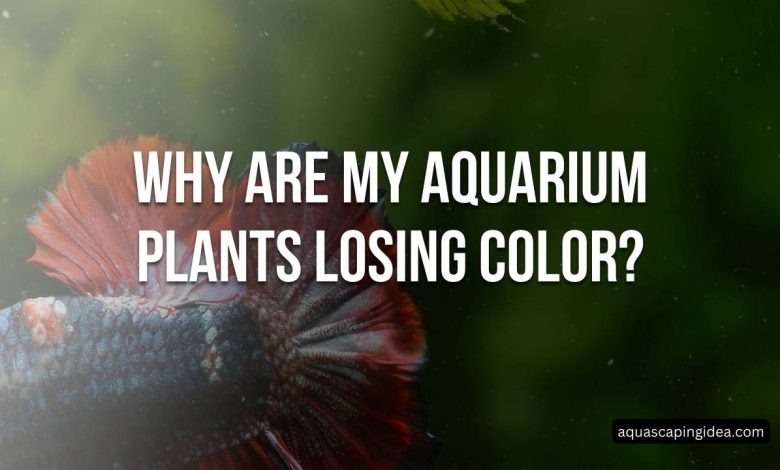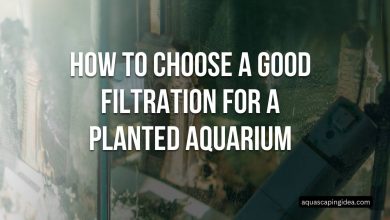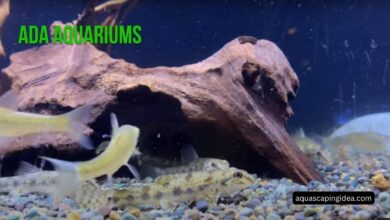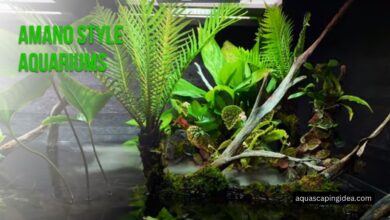
Aquarium plants can lose their vibrant green color due to several reasons. Insufficient lighting is a common culprit, as plants require adequate light intensity and duration for photosynthesis. Nutrient deficiencies, especially lack of iron, can also cause plants to turn pale or yellow. Excessive algae growth can block light and outcompete plants for nutrients. Poor water quality with high levels of ammonia, nitrites or low CO2 levels can inhibit plant growth and health. Finally, some plant species naturally undergo color changes as they age or transition through different growth stages. Addressing lighting, nutrients, water parameters and algae issues can help revive fading plants.
Mystery of Color Loss in Aquarium Plants
It starts with just a few leaves here and there. Then you notice entire stems turning a muted green or even transparent. Before long, the brilliant red and purple hues that first caught your eye at the plant store have virtually disappeared in your aquarium.
What causes some species of aquarium plants to lose their intense colors over time? And what can you do to preserve and enhance the dazzling rainbow palette in your underwater garden? This guide tackles the various factors at play when prized specimens seem to be fading rather than thriving.
We’ll explore the science behind plant pigments and look at common stumbling blocks hobbyists encounter with aquatic plant health. Follow our troubleshooting tips to get your green thumbs—and your plants—back on track to maximum color and vitality.
Decoding the Pigments Behind Plant Color
To understand what makes aquarium plants turn colorless, it helps to know what gives them color in the first place. The vibrant hues we admire in species like alternanthera, ludwigia, and cabomba come from two groups of pigments:
Chlorophyll – These green pigments are essential for photosynthesis. Chlorophyll A traps violet-blue and reddish light extremely well to fuel plant growth. The other form, chlorophyll B, absorbs blue light and green light. All plants contain both pigments, giving them a green overtone.
Accessory Pigments – These include carotenoids (yellows, oranges), phycobilins (reds) and anthocyanins (purples, reds). Working with chlorophyll, this mix of accessory pigments captures a wider spectrum of light to help plants flourish. They also protect chlorophyll from excess light damage.
What Triggers a Loss of Plant Color Over Time?
If plants have adequate nutrients, stable growing conditions, and proper aquarium care, their colors should remain consistently eye-catching. So when your purple cabomba turns green or red ludwigia grows transparent, it signals something in the environment has changed.
Trouble typically starts with one or a combination of the following factors:
Insufficient Light Without sufficient lighting intensity or duration, plants ramp down accessory pigment production and revert to mostly chlorophyll green. Shoot for 8-10 hours daily of 40-60 lumens per liter of aquarium volume.
Poor Nutrient Levels
Macronutrients like nitrogen and potassium plus micronutrients such as iron allow plants to synthesize colorful accessory pigments. Deficiencies show as fading or smaller leaves.
Temperature Stress
If tank temperatures drop too low or fluctuate widely, plants change their pigment mix and growth stalls. Maintain 72-82°F for tropical freshwater species.
Improper Carbon Dioxide
Injecting CO2 enables fast growth and maximum color in stem plants. But too little or too much CO2 causes health decline and greening.
pH Imbalance
Each aquatic plant species thrives in a preferred pH range. Dramatic shifts up or down affect nutrient uptake and pigment production.
Toxic Buildup & Algae Growth
Excess nitrate, waste organics, heavy metals or smothering algae disturb plant processes and stunt color expression.
New Tank Syndrome
It takes months for a new aquarium system to build stability and optimum conditions as substrates mature and the biofilter establishes. Be patient!
Troubleshooting Strategies to Restore Lost Color
Don’t panic if your plants start fading to green or clear. There are almost always ways to coax color back with a few adjustments. Let’s go step-by-step through some key troubleshooting tactics:
Scrutinize Lighting & Duration
Too little light is the reason red plants turn green. Assess bulb age, height, positioning, lumens output and edges where plants lack penetration. Slowly increase hours of light 10-12 hours or raise fixtures until color improves. Add reflectors to focus light if needed.
Review Fertilizer Scheme & Nutrients
Test water for nitrogen, phosphate, iron and trace elements essential to plant pigments. Start or revise fertilization to supply deficient nutrients. Avoid sudden overdosing that could shock plants. Consider specialty substrates like Fluval or ADA aquasoil to provide slow-release nutrition.
Confirm Ideal Temperature Range
Use a reliable heater and thermometer to keep tank temperatures in the 72-82°F sweet spot. Monitor conditions to prevent uncontrolled swings, especially at night or different spots around aquarium. Maintain stability.
Check Filter Flow & Surface Gas Exchange
Reduced oxygen and carbon dioxide exchange at the water surface limits plant processes and growth. Ensure filter outlets ripple 50% of the surface and distribute flow well to all areas without being too turbulent. Clean clogged intakes too.
Tweak CO2 Injection & Test pH Daily
Using compressed CO2 often benefits red plants but requires close monitoring. Very gradual changes to reach 15-30 ppm carbon dioxide concentration prevents pH crashes. Install a drop checker, test pH routinely and make subtle bubble count adjustments.
Attack Algae & Export Organic Waste
Improve system maintenance to prevent green water, beard algae, black brush algae and other pests from smothering plants or monopolizing nutrients. Clean filters, siphon the substrate and perform larger, more frequent water changes of 30-50% to reduce organics. Add algae eaters too.
Be Patient With Color Bounce Back
As you methodically eliminate environmental stress factors, keep watching for signs of improvement in plant color and vigor. Growth processes lag behind improvements you implement, so wait a good 4-6 weeks before further tweaks.
Ultimately finding balance between lighting, nutrients, CO2, temperature, water parameters and tank maintenance creates the right habitat for colorful aquatic plants to shine. Consistency pays off. Stick with a regimen once plants perk up. Then enjoy the fruits of your labor as brilliant hues return!
FAQs About Aquarium Plant Color Loss
What causes red or purple aquatic plants to lose color?
Insufficient nutrients like nitrogen, low iron, poor CO2 exchange and low light often trigger color loss in red plants. Deficiencies make plants revert to mostly green chlorophyll production.
Why did my plants fade after the first few months?
New tank systems take months to build stability, beneficial bacteria and available nutrients as substrates mature. Plant fading after initial vigor is common. Be patient, avoid overstocking too soon and supplement nutrients.
What is the fastest way to restore color?
Boosting light intensity 10-30% and duration to 10-12 hours daily prompts the quickest color return. Adding supplemental CO2 and comprehensive fertilizers kickstarts growth and pigment development too.
My plants are almost transparent. Are they dying?
Clear leaf tissue can mean plants are struggling but doesn’t always signal death. Improve environmental conditions and remove dying leaves. Healthy growth should resume with time as stress factors are corrected. Don’t prematurely discard specimens unless all tissue dies.
Why do the middle and lower leaves turn clear first?
As older leaves weaken, plants shuttle nutrients to new growth. Signs of deficiencies show in lower foliage first. Prune dying leaves so plants invest energy in top stems and crowns for optimal regeneration.
The Secret to Lasting Vibrancy
Preserving the dazzling rainbow palette of colors that aquarium plants offer brings great reward to hobbyists—but it requires dedication to balancing habitat stability, nutrients and care. Use the troubleshooting tips here to maintain consistency plants need to keep pigments bright season after season. Then enjoy a brilliant underwater garden thriving at its peak!




